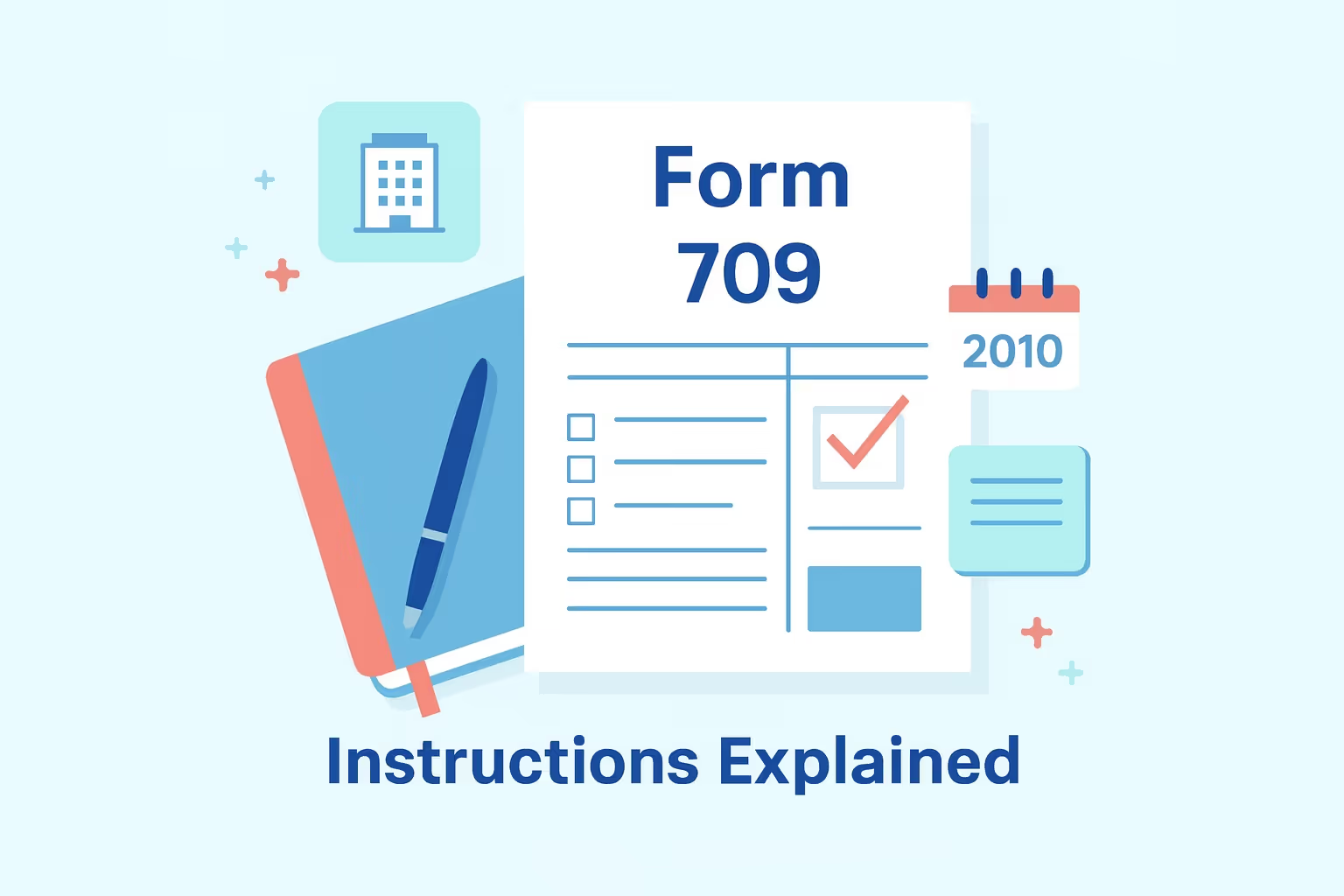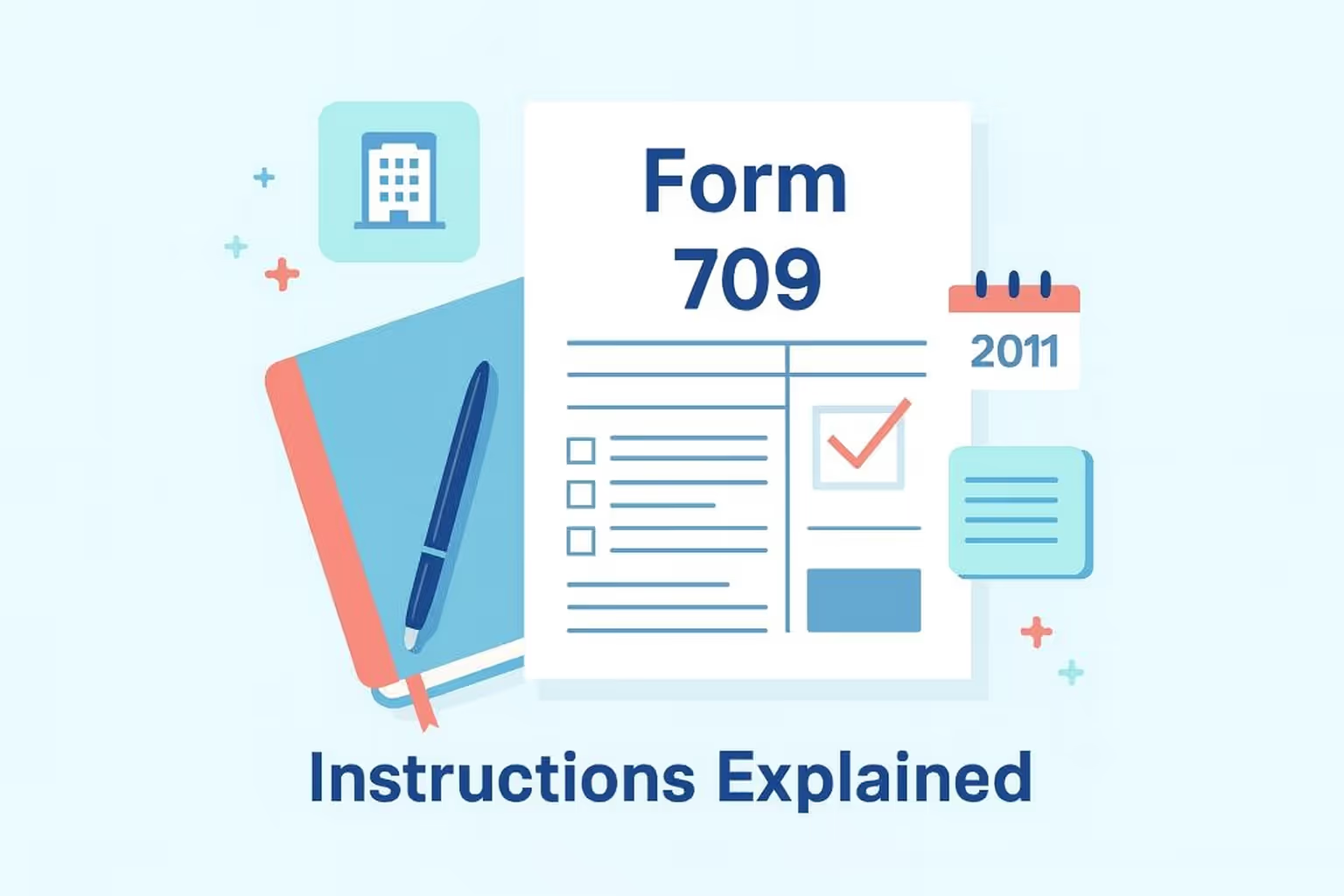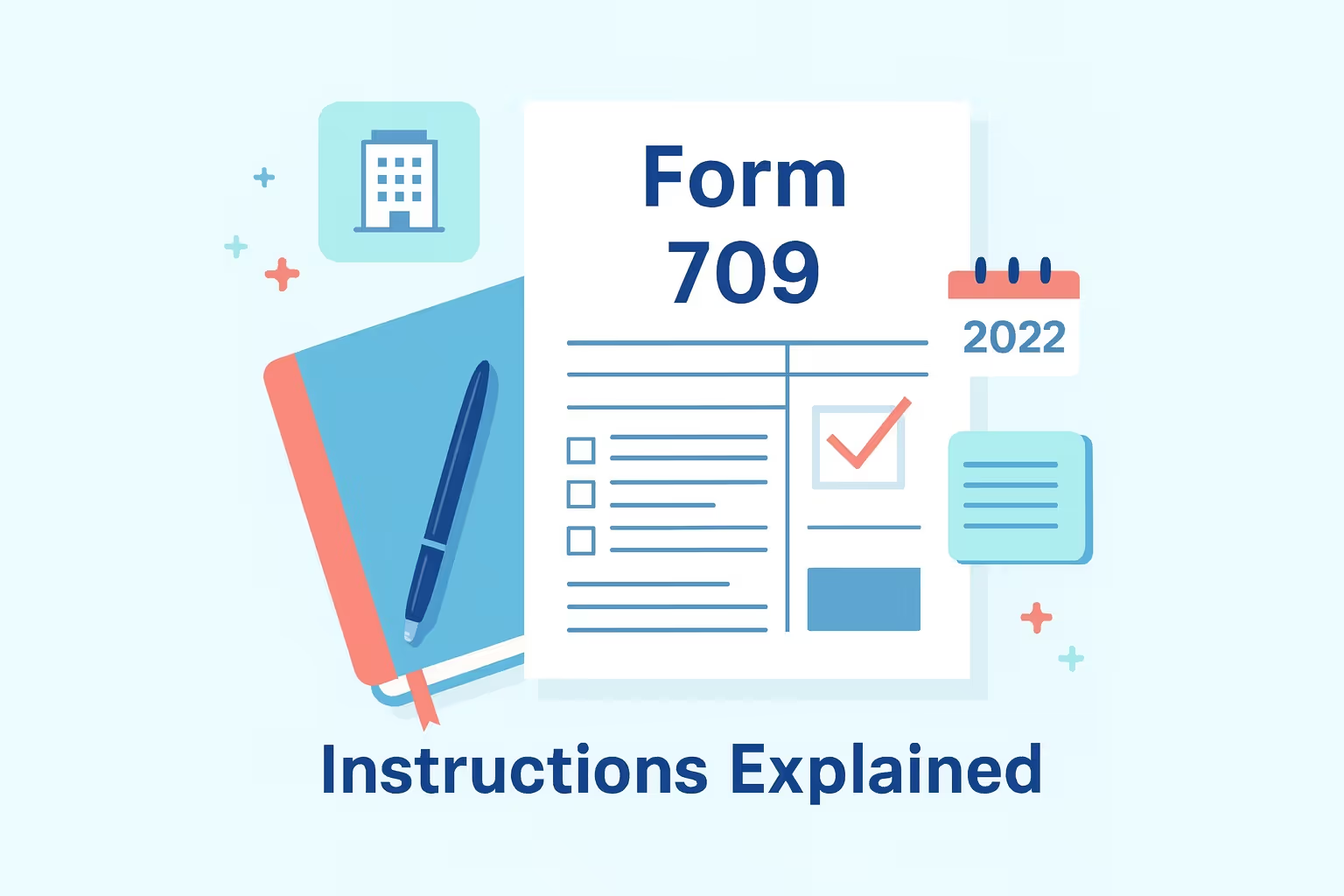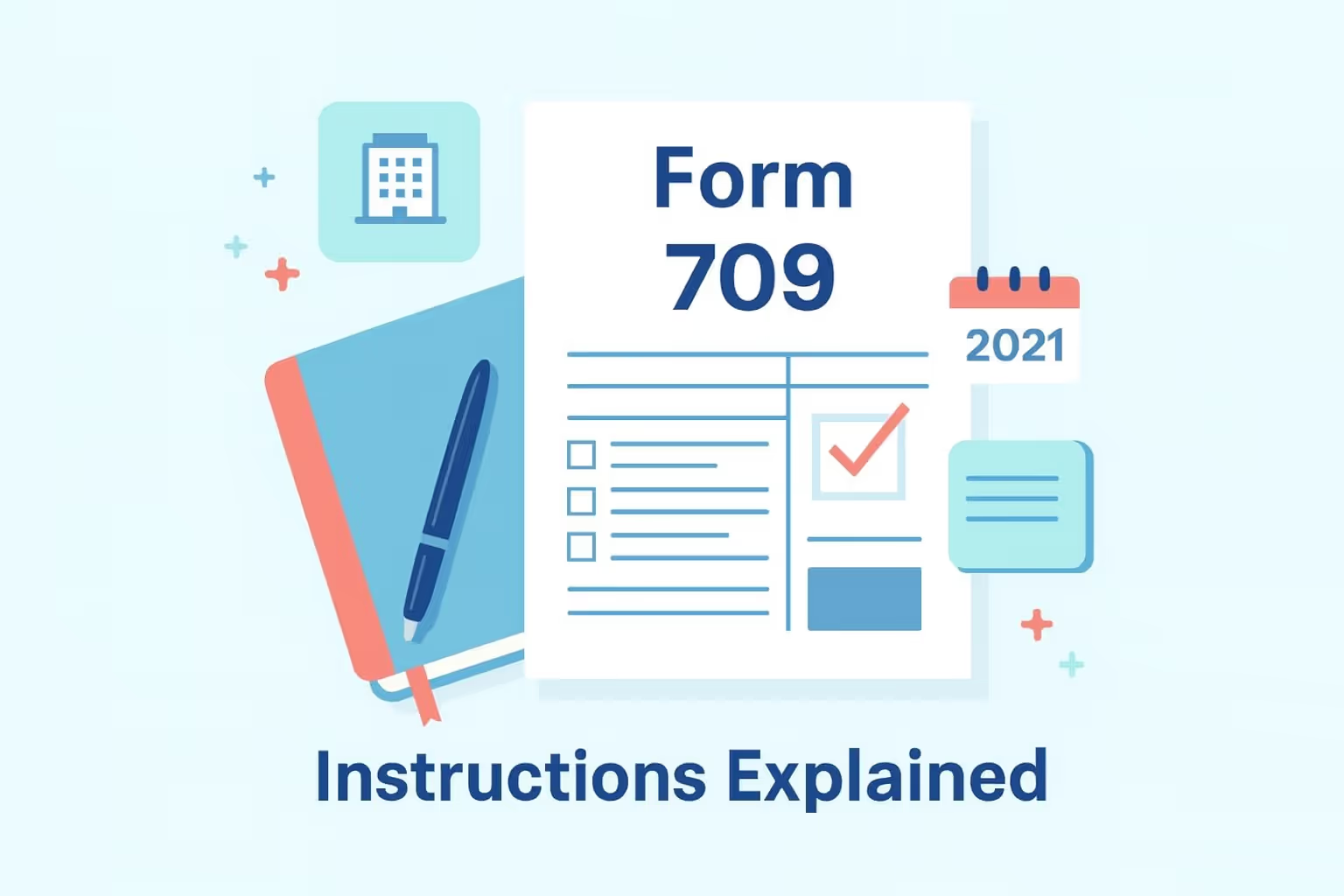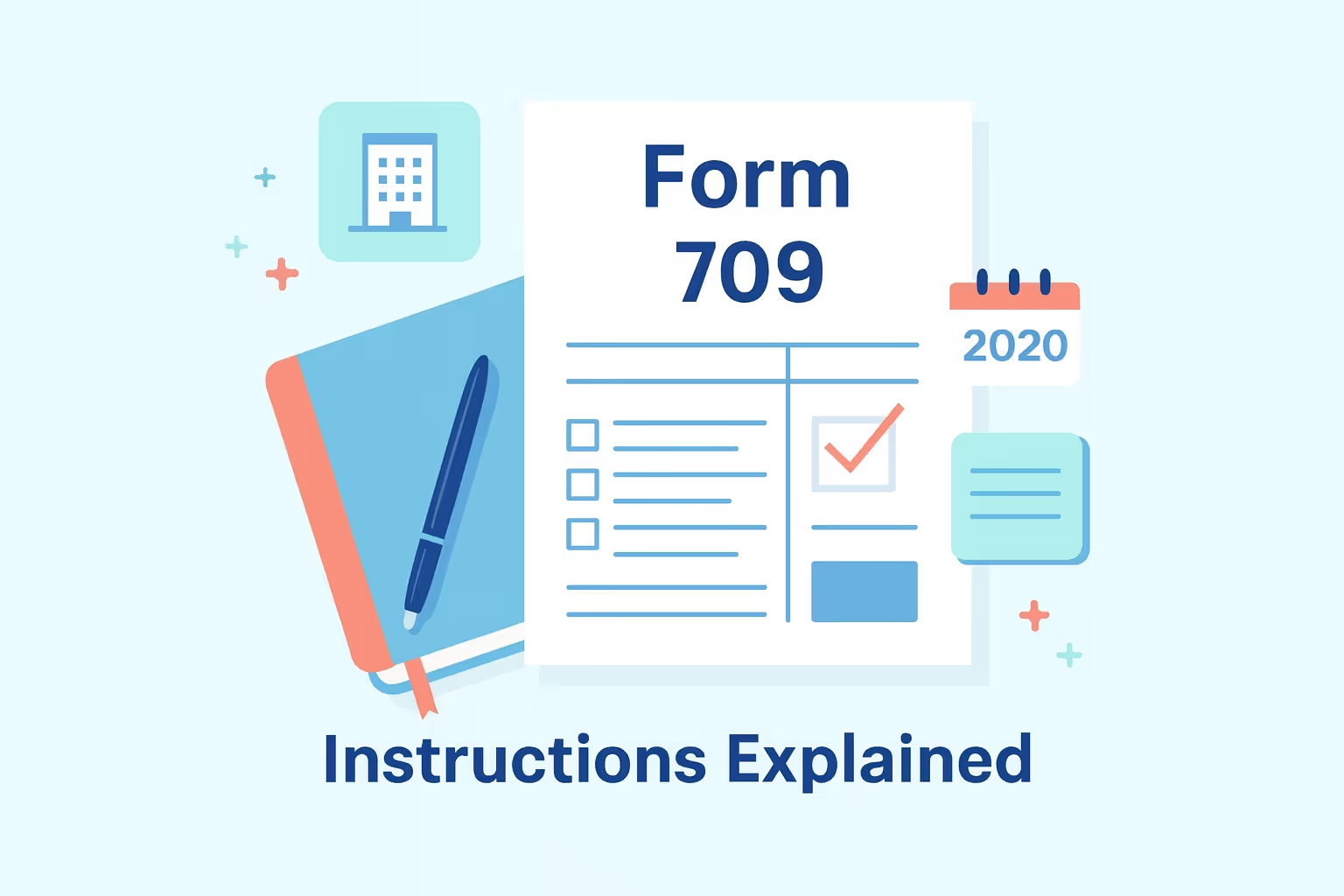Filing a Federal gift tax return can feel intimidating, especially if you’re preparing Form 709 for the first time. The form, officially titled United States Gift (and Generation-Skipping Transfer) Tax Return, reports certain gifts made during the year that exceed the annual exclusion amount. This guide explains how to file Federal Form 709 for Tax Year 2023, what information you need, and how to avoid common mistakes.
For 2023, the Internal Revenue Service (IRS) requires individuals to report gifts made between January 1 and December 31, 2023, if they exceed specific limits. These returns were due by April 15, 2024, though extensions were available for those who filed Form 4868 or Form 8892. Even if no tax is owed, filing may still be required under IRS rules, particularly when gift-splitting or generation-skipping transfers are involved.
This article follows official IRS Form 709 instructions (2023) and briefly breaks down each step. Whether you’re giving cash, property, or other assets, this guide will help you accurately complete your Federal gift tax return and understand how it fits within your lifetime gift and estate planning.
Understanding Federal Form 709 and When You Must File
Form 709, officially titled United States Gift (and Generation-Skipping Transfer) Tax Return, reports gifts that exceed the annual gift tax exclusion or involve transfers affecting the lifetime exemption for gift tax and future estate tax. The Internal Revenue Service (IRS) requires this form to track gifts that may reduce available tax exemptions over time.
For tax year 2023, the annual exclusion amount is $17,000 per recipient. Gifts up to this amount can be given to any number of people without filing. When a single recipient receives more than $17,000 in 2023, Form 709 (2023) must be filed, even if no tax is owed. The form also applies to generation-skipping transfers (GST)—gifts made to grandchildren or unrelated individuals more than one generation younger than the donor. The official IRS guide provides detailed filing instructions for IRS Form 709.
When Filing Is Required
A federal gift tax return is required for 2023 if any of the following apply:
- Gifts exceeded $17,000 to a single recipient: The total value of gifts to one person surpassed the annual exclusion amount.
- Spouses elected to split a gift: Each spouse must file a separate return, even if only one made the gift.
- Gifts were made to a non-U.S. citizen spouse: Filing is required if the total exceeded $175,000 in 2023.
- Future interest gifts were made: These include transfers through trusts or gifts that beneficiaries receive at a later date.
- Generation-skipping transfers occurred: Direct or indirect transfers to grandchildren or younger recipients must be reported.
When Filing Is Not Required
Certain transfers are excluded from filing requirements, even if they exceed typical limits:
- Tuition payments are made directly to educational institutions.
- Medical expenses paid directly to healthcare providers.
- Gifts to political organizations or qualified charitable donations.
These transfers are excluded because they are considered tax-free gifts under IRS rules.
Key Updates and Gift Tax Limits for 2023
Several vital updates changed how federal gift tax rules apply for the tax year 2023. These adjustments reflect inflation indexing and updated exclusions established by the IRS.
- Higher annual gift tax exclusion: Increased from $16,000 in 2022 to $17,000 per recipient in 2023. A donor can now transfer up to $17,000 to any individual without filing a gift tax return.
- Increased exclusion for gifts to non-U.S. citizen spouses: The exclusion rose from $164,000 in 2022 to $175,000 in 2023. Gifts to non-citizen spouses above this amount must be reported on Form 709, while gifts to U.S. citizen spouses remain unlimited and are not subject to filing.
- Lifetime gift and estate tax exemption unchanged for 2023: The combined lifetime gift and estate tax exemption is $12.92 million, with an identical generation-skipping transfer (GST) exemption. These limits allow most individuals to make significant gifts during their lifetimes without owing tax, provided cumulative taxable gifts remain below the threshold.
- New reporting for digital assets: The IRS added a question about digital assets on Line 20 of Form 709. Donors must indicate whether any gifts included cryptocurrency, tokens, or other digital property
Gift and Estate Tax Limits: 2022 vs. 2023
Annual Exclusion (per recipient)
- 2022: $16,000
- 2023: $17,000
Non-Citizen Spouse Exclusion
- 2022: $164,000
- 2023: $175,000
Lifetime Gift/Estate Exemption
- 2022: $12.06 million
- 2023: $12.92 million
GST (Generation-Skipping Transfer) Exemption
- 2022: $12.06 million
- 2023: $12.92 million
You can refer to the official IRS instructions for Form 709 for a full breakdown of rules and instructions.
Step-by-Step Guide to Completing Form 709
Completing Form 709 takes organization and accuracy. Following each step carefully helps ensure your filing complies with Internal Revenue Service (IRS) requirements and avoids delays or penalties. The guidance below summarizes the 2023 filing process based on official IRS instructions.
Step 1 – Gather All Required Information
Before starting, organize every document that supports the return. Having a complete record avoids missed entries and speeds up preparation.
- Donor and recipient details: Gather names, addresses, and Social Security numbers (if available). Include the recipient’s relationship to the donor.
- Gift information: Record each gift's date, description, and fair market value. For property, note how the value was determined and keep supporting documents.
- Prior filings: Retrieve earlier gift tax returns to calculate the remaining lifetime gift tax exemption and credit used.
- Supporting documents: Keep trust agreements, insurance policies, and Form 712 for life insurance gifts.
- Appraisals: Secure professional valuations for non-cash gifts worth more than $5,000.
- Deceased spouse records: Retain a copy of the deceased spouse’s Form 706 if using the deceased spousal unused exclusion (DSUE).
Step 2 – Complete Page 1 (General Information)
- Start with personal information, then address elections and key questions.
- Provide the donor’s name, address, and Social Security number. Indicate marital status and check the box for gift splitting if a joint election is made. Both spouses must file separate Forms 709 and sign Line 7 as the consenting spouse.
- Mark “Yes” on Line 11 if filing an amended return. In Line 20, answer the new question about digital assets that disclose cryptocurrency or other digital transfers.
- Once all information is entered, sign and date the form. Missing signatures or incorrect elections can invalidate the return or delay processing.
Step 3 – Report Gifts on Schedule A
Schedule A is the foundation of the return. This is where all reportable gifts for 2023 are listed.
- Parts of Schedule A:
- Part 1: Gifts subject only to gift tax (to non-skip persons).
- Part 2: Direct skips are subject to both gift and GST tax.
- Part 3: Indirect skips and trust transfers.
- Part 1: Gifts subject only to gift tax (to non-skip persons).
- Use fair market value on the date of transfer. Use the average of the day’s high and low trading prices for stock gifts. Clearly describe each property to meet adequate disclosure standards.
- Subtract the annual gift tax exclusion of $17,000 per recipient for 2023.
Example:
If a donor gave $25,000 to an adult child, $17,000 qualifies for the exclusion, leaving an $8,000 taxable gift to report. Gifts of future interest—like trust distributions received later—must be reported in full, without exclusions.
Step 4 – Record Prior Period Gifts on Schedule B
- Schedule B summarizes prior taxable gifts and tracks the available lifetime gift tax exemption. Accurate reporting ensures the total credit matches IRS records.
- Use earlier Forms 709 and related IRS correspondence to confirm totals from previous years. Consistency prevents discrepancies that could affect later estate filings.
Step 5 – Complete Schedules C and D (DSUE and GST)
- Schedule C (DSUE): If using a deceased spouse’s unused exemption, include the spouse’s Form 706, the election confirmation, and any closing letter. This increases the donor’s exclusion amount for the year.
- Schedule D (GST): Report any generation-skipping transfers and apply the GST exemption as needed. Confirm whether the exemption is automatically allocated or must be applied manually for trusts or skip-person gifts.
Step 6 – Review and Attach Supporting Documents
Review the entire return carefully before filing. Attach the documents required to substantiate reported amounts.
- Appraisals and valuation exhibits: Include professional appraisals for real estate, business interests, or artwork.
- Form 8283: Attach when applicable to document specific non-cash charitable contributions.
- Form 712: Required for life insurance policy transfers.
- Trust agreements: Provide sections describing property transfers and any valuation terms.
- Split-gift filings: When splitting gifts, mail both spouses’ returns and confirm both signatures are present.
Careful preparation ensures accurate reporting, preserves the lifetime exemption, and keeps your records in line with federal estate and gift tax requirements. Following these steps closely helps avoid IRS inquiries and simplifies future estate planning.
How to File Your 2023 Federal Gift Tax Return
Filing Form 709 correctly is essential for proper reporting and long-term tax purposes. Whether a single person, married couple, or donor spouse, the process must follow the same steps to ensure compliance with the federal tax rules governing gift tax purposes and estate planning. Each return must reflect the full value of transferred property and any exclusions or credits that apply.
Filing Methods and Deadlines
Most gift givers for the 2023 calendar year must still submit paper filings, as electronic options were not widely available. The initial form should be mailed to the IRS Kansas City, MO Service Center for original returns. Amended or supplemental filings should be sent to Florence, KY.
- Filing deadline: April 15, 2024
- Extended due date: October 15, 2024, if you filed Form 4868 or Form 8892
Timely filing is essential because the estate tax inclusion period begins once a valid return is accepted. Filing late could increase gift tax liability or cause valuation issues for future estate reviews.
When the Gift Tax Applies
The gift tax rate ranges up to 40%. Still, most gift givers owe no immediate tax because the lifetime exclusion—set at $12.92 million for 2023—absorbs taxable amounts above the annual gift tax limit of $17,000 per recipient. The lifetime limit applies across all years and must be tracked carefully to protect the lifetime estate exemption.
The gift tax also applies to such transfers as life estates, qualifying domestic trusts, and gifts to a third-party donee when the donor retains some benefit. For married couples, a gift splitting election allows each spouse to treat a gift as made half by each, doubling the annual limit and reducing future gift tax liability. If only one spouse makes a transfer, both still must file gift tax returns for that year.
Additional Filing Tips
- Always report the set dollar amount for each gift at its fair market value.
- Confirm such gifts meet the filing threshold before reporting.
To ensure compliance, a surviving spouse using portability should reference the prior spouse’s DSUE amount. - Consult a qualified tax professional when complex trusts, foreign recipients, or multi-year gifts are involved.
By understanding these requirements, taxpayers can meet all obligations, accurately pay taxes when necessary, and ensure that such a transfer aligns with long-term estate and tax purposes.
Payment and Gift Tax Exemptions
Most individuals who file Form 709 do not immediately owe gift tax. This filing primarily aims to track cumulative lifetime gifts and determine how much of the lifetime gift and estate tax exemption has been used. For 2023, this exemption remains at $12.92 million, protecting most donors from paying out-of-pocket tax when they file a gift tax return.
When Payment Is Required
Tax payments apply only when the total value of taxable gifts during a person’s lifetime exceeds the available exemption. The annual exclusion ($17,000 per recipient for 2023) excludes a portion of gifts each year. Once cumulative taxable gifts surpass the lifetime exemption, a payment must accompany the return.
Example: If an individual makes $50,000 in taxable gifts for 2023, the amount simply reduces the remaining lifetime exemption. No payment is due unless all lifetime taxable gifts exceed $12.92 million.
Payment Options
Taxpayers can choose one of the following methods to pay any gift tax due:
- Check or Money Order. Payments should be made payable to the United States Treasury, with the donor’s Social Security number, tax year, and “Form 709” noted on the memo line. Attach the payment to the front of the return before mailing.
- Electronic Payment. The Electronic Federal Tax Payment System (EFTPS) allows online payments directly to the IRS. This secure method ensures timely receipt when the due date is near.
Gift Splitting and Exemption Management
- Gift-splitting election for married couples: Married couples can reduce their potential gift tax exposure by choosing to split gifts. This election allows each spouse to treat one-half of a joint gift as their own, effectively doubling the annual exclusion and preserving a greater share of the lifetime exemption for future years.
- Maintain thorough records: Donors should keep copies of all filed Forms 709, professional appraisals, payment confirmations, and supporting documents. These records verify how valuations and exemptions were applied and help ensure accuracy if the IRS requests clarification.
- Prioritize accuracy and timeliness: Filing carefully, maintaining organized documentation, and submitting timely payments ensure compliance with federal rules and protect exemption amounts available for future transfers or estate planning purposes.
Common Errors and Filing Mistakes to Avoid
Filing Form 709 requires attention to detail. Even minor oversights can delay processing or create future issues with estate and gift tax records. Reviewing common errors before submission helps ensure accuracy and compliance.
- Missing the filing deadline: Returns for gifts made in 2023 were due April 15, 2024. Filing late can trigger penalties and interest, even when no tax is owed. An extension filed with Form 4868 or Form 8892 moves the due date to October 15, 2024, but payment must still be made by the original deadline.
- Using the wrong mailing address: Original returns should be mailed to the IRS Kansas City (State of Missouri) Service Center, while amended returns go to Florence, Kentucky. Mailing to the wrong location can delay processing or lead to lost documents.
- Forgetting to apply the annual exclusion: Each donor can exclude up to $17,000 per recipient in 2023. Omitting this step inflates taxable gift amounts and reduces the remaining lifetime exemption.
- Incorrect or missing valuations: Use fair market value on the date of transfer. Always attach appraisals for real estate, business interests, or other non-cash assets over $5,000.
- Split-gift mistakes: When making a gift-splitting election, both spouses must file separate Forms 709, sign the consent on Line 7, and mail the returns together. Missing a signature or filing separately can invalidate the election.
- Incomplete information. Failing to include recipient addresses, relationship details, or explanations for unusual gifts may cause the IRS to request clarification or reject the return.
Careful review before mailing ensures that reported gifts, elections, and exclusions are accurate. Double-checking totals, signatures, and attachments helps protect exemption amounts and prevents avoidable filing issues.
Filing Rules for Zero-Activity or Dormant Years
Not every taxpayer needs to file Form 709 each year. A return is generally unnecessary when no reportable gifts are made during the calendar year. However, certain elections or protective actions still require filing even when no taxable gifts occur.
- No filing required: If total gifts remain within the annual exclusion—$17,000 per recipient for 2023—no filing is needed. Routine, small gifts to family members or friends that stay under this limit do not trigger a reporting obligation.
- GST or protective elections: Filing may still be required to make or revoke a generation-skipping transfer (GST) election. Some taxpayers also file to preserve exemption allocations or to make protective elections for future transfers.
- Gift-splitting elections: Married couples who share gifts under the exclusion threshold must still file if they choose to split gifts. Both spouses must complete separate returns and sign Line 7 to validate the election.
- Other notable cases: Filing is recommended if gifts were made to trusts, involved complex terms, or carried forward from a previous estate plan. These filings document intentions and prevent later disputes.
Submitting a return for a “dormant” year is often optional, but can provide valuable protection. Proactive reporting helps maintain accurate lifetime exemption tracking and ensures all elections are correctly recorded with the Internal Revenue Service.
Tips for First-Time Filers
Filing Form 709 for the first time can be intimidating, but understanding the process makes it much easier to complete accurately. These practical tips help new filers comply, especially when gifts involve unique situations or shared ownership.
- Confirm filing requirements early: Review each transfer to determine whether it exceeds the annual exclusion or qualifies as a reportable gift. If unsure, consult the Form 709 instructions or a tax professional.
- Understand joint filing rules: When spouses share gifts, each must file a separate joint gift tax return to make the gift-splitting election valid. Both returns should include signatures and identical information about the gifts made during the year.
- Disclose complex gifts clearly: Some transfers, including those with a terminable interest—a right that ends upon death or another event—need special documentation. These gifts can limit the marital deduction, so providing detailed explanations and supporting documents helps ensure accuracy and prevents IRS processing delays.
- Be aware of special elections: The IRS provides a special rule for reporting generation-skipping transfers through trusts or to grandchildren. These elections determine how the automatic allocation of the GST exemption applies and should be reviewed carefully before filing.
- Keep accurate records: Store copies of all Forms 709, appraisals, trust agreements, and correspondence. Organized documentation supports future estate planning and ensures lifetime exemption tracking remains accurate.
Completing the first Form 709 carefully builds a foundation for future compliance. Accuracy, clarity, and strong recordkeeping allow new filers to confidently manage their gift reporting responsibilities.
Frequently Asked Questions (FAQs)
Who must file Form 709 for 2023?
Anyone who gave gifts over the annual exclusion of $17,000 per recipient in 2023 must file Form 709. Filing is also required for gift-splitting elections, transfers to non-U.S. citizen spouses, or generation-skipping gifts. Even if no tax is owed, filing ensures the IRS accurately tracks your available estate tax exemption and cumulative lifetime exemption usage.
What is the 2023 amount for the annual gift tax exclusion?
The annual gift tax exclusion for 2023 is $17,000 per person. You can give up to this amount to anyone without filing Form 709. Gifts that exceed the limit must be reported, though most taxpayers owe no tax because the lifetime exemption offsets excess amounts before the estate tax applies at death.
Can Form 709 be filed electronically?
No, for the 2023 tax year, Form 709 had to be mailed as a paper return. The IRS Kansas City (State of Missouri) Service Center handled original filings, and Florence, KY, processed amended ones. While e-filing may expand in future years, all 2023 federal gift tax returns must be filed by mail to ensure compliance and timely processing.
What happens if Form 709 is filed late?
Late filing may result in IRS penalties or interest, even when no tax is owed. The penalty amounts to up to 5% of the unpaid monthly tax per month, up to 25%. Filing Form 4868 or Form 8892 extends the due date to October 15, 2024, but payment must still be made by April 15, 2024, to preserve your estate tax exemption.
Do tuition or medical payments count toward the annual exclusion?
No, payments made directly to a school or healthcare provider are excluded from gift tax and do not reduce your annual exclusion or estate tax exemption. However, paying the same expenses through the recipient—rather than directly to the institution—qualifies as a reportable gift and must be included on Form 709 for proper tracking by the IRS.




























